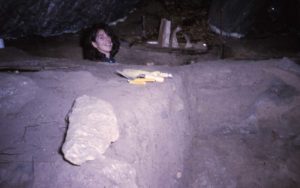Binette Rock Shelter

The Binette Rock Shelter located in Naugatuck, CT was excavated by the Greater New Haven Archaeological Society under the direction of David H. Thompson. Archaeological evidence from Binette suggests that it was periodically occupied by small groups from the Paleo-Indian period through the Contact period. Due to the intermittent nature of these occupations, it is referred to as one of Connecticut’s earliest “motels.” The rock shelter consists of two large boulders forming an 18’ x 10’ enclosure with entrances on both sides making it the perfect place for travelers seeking temporary refuge against the natural elements.
The lowest stratigraphic level containing cultural material yielded a radiocarbon date of 4,340 ± 120 BP, placing this occupation during the Late Archaic period. Lithics recovered from this level include Vosburg, Brewerton Ear-Notched, and Beekman Triangular projectile points, all of which are associated with the Vosburg Phase.
The next level contained burnt bones, various food remains such as fish scales and bivalve fragments, and a Terminal Archaic Susquehanna broad point. A Late Woodland component was also represented in this level with the discovery of several triangular points, pieces of worked bone, and potsherds.
Two features, a fireplace and nearby stone bench, were found in the upper stratigraphic level. Historic artifacts including several Kaolin pipe fragments, hand wrought iron nails, and a creamware bowl were also recovered. Additionally, heavily worn flint and other gun hardware indicate an English presence during this episode of occupation, but whether or not these were discarded by Indigenous people is still in question.
Citation:
David H. Thompson
1969 The Binette Site, Naugatuck, Connecticut. Eastern States Archaeological Federation Bulletin 27/28:14-15.
2007 Personal communication.

